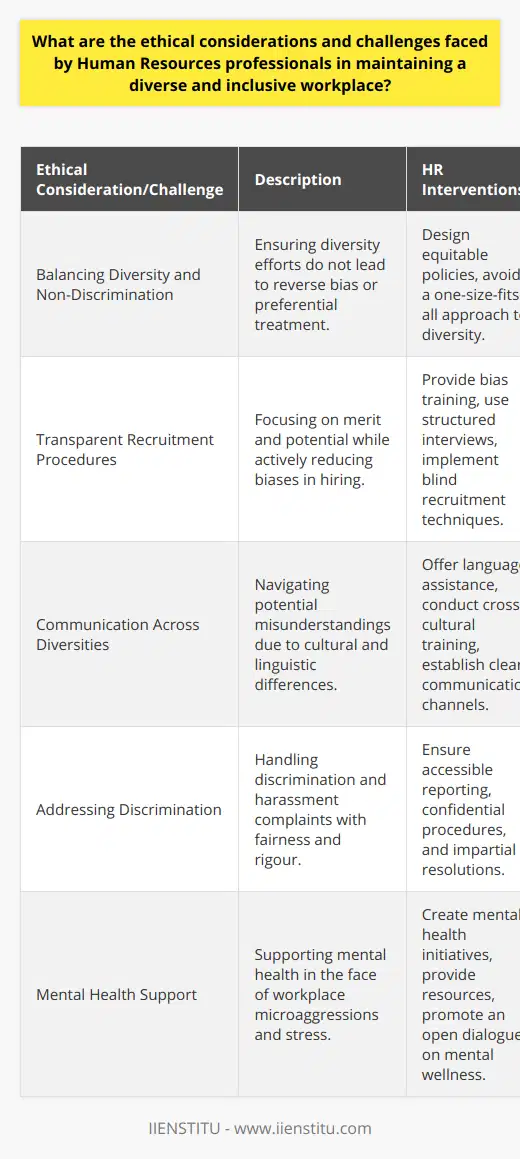
If you're interested in a career in human resources management, you're in luck. There are many different jobs available in this field, and no two are the same. So what's it like to work in human resources? Let's take a look at some of the most common careers in this field.
The first step in any career in human resources management is to gain the skills and knowledge necessary for success. Many people complete a degree or certificate program in human resources or take on internships and other practical experience opportunities. By participating in the human resources management certificate program, you can improve yourself and step into the HR world.
How to get a job in HRM. 10 Top Jobs in Human Resource Management
Related Course: Human Resources Certification
After you have obtained the necessary education and training, there are numerous career opportunities available to you. Some of the most common roles in human resources management include recruiting new employees, overseeing human resources policies and procedures, and administering employee benefits programs.
Other potential job options include human resources consulting, labor relations, human capital management, and compensation planning. With the right qualifications, you can pursue a fulfilling career in human resources that allows you to make a positive impact on organizations and individuals alike. Whether you choose to work as an internal HR professional or go into business for yourself as a human resources consultant, there are many exciting possibilities ahead of you. So start exploring your options today and discover where a passion for people can take you! Some of the most common roles include:
1 - Recruiter - Recruiters are professionals who identify potential job candidates, conduct interviews, and offer employment.
As a recruiter, one of your primary responsibilities will be to identify and assess potential candidates for open positions within an organization. In order to be successful in this role, you must have strong interpersonal skills that allow you to build relationships with potential candidates. Additionally, you must have excellent interviewing abilities in order to evaluate an individual's qualifications and determine whether they are the right fit for the available position.
Whether you're recruiting entry-level employees or more seasoned professionals, the ability to connect with others and accurately assess their qualifications will be crucial in ensuring that your organization's talent needs are always met. So if you're looking for a career that's intellectually stimulating and rewarding, consider becoming a recruiter today.
As a human resources manager with 20 years of experience in the field, I have a great deal of advice to offer to anyone looking to pursue a career in recruitment. First and foremost, it is essential to be patient and persistent when looking for job opportunities or networking with potential employers. This involves taking the time to thoroughly research companies and industries before reaching out, as well as being willing to follow up with hiring managers or human resources professionals even if they respond later. Another critical factor is having strong communication skills and the ability to sell yourself effectively and your qualifications.
It is also helpful to stay up-to-date on new trends and developments within the industry so that you can be confident about recommending viable solutions for your clients or potential employers. Overall, if you are dedicated, motivated, and prepared to put in the time and effort required for success in human resources management, there are many rewarding opportunities ahead of you.
Recruitment specialist tasks
1. Posting job advertisements
2. Screening resumes
3. Conducting initial interviews
4. Checking references
5. Coordinating interviews with hiring managers
6. Negotiating salaries
7. extending job offers
8. conducting orientation sessions
2 - Benefit specialist - If you are looking for a career with purpose, consider becoming a benefits specialist.
As a benefits specialist, it is your job to manage and coordinate employee benefits programs like health insurance, retirement plans, and other perks. This means that you need to be highly organized and detail-oriented, as well as skilled with numbers. Additionally, you must be able to work well with a wide range of people in order to create effective benefits packages tailored to the needs of individual employees.
In this role, you will also provide guidance on how these benefits can best support employees throughout their careers. As such, it is vital that you have excellent communication skills and a thorough understanding of human resources management principles. With all these skills and qualities, you are sure to succeed as a benefits specialist in today's rapidly changing workplace.
Benefit specialist tasks
As a benefits specialist, you will be responsible for administering employee benefits programs. This includes developing and managing programs such as health insurance, retirement plans, and paid time off. You will also be responsible for communicating information about these programs to employees and answering any questions they may have.
Another task you may be responsible for as a benefits specialist is conducting open enrollment for employee benefits programs. This involves communicating information about the program changes to employees and helping them to enroll in the appropriate coverage. You will also need to answer any questions that employees may have during this process.
You may also be responsible for managing claims for employee benefits programs. This includes working with insurance companies to ensure that claims are processed correctly and in a timely manner. You will also need to assist employees with filing claims and answering any questions they may have about the process.
As a benefits specialist, you will also be responsible for managing the budget for employee benefits programs. This includes tracking expenses and ensuring that the programs remain within budget. You will also need to work with vendors to negotiate contracts and get the best possible rates for services.
In addition to the tasks mentioned above, you may also be responsible for conducting research on new employee benefits programs. This includes evaluating different options and making recommendations to management on which programs would be most beneficial for the company. You will also need to stay up-to-date on changes in the law that could impact employee benefits programs
3 - Compensation manager - If you're looking for a career that is both challenging and rewarding, consider becoming a compensation manager.
As a compensation manager, your primary focus is to ensure that employees are adequately motivated and engaged in their work. To do this, you must have a keen understanding of human psychology and be skilled at negotiating with individuals and groups. This requires the ability to read people and understand what drives them, as well as solid communication skills that allow you to communicate your plans and goals to others effectively.
Additionally, since compensation programs involve financial resources, it is critical to possess excellent analytical skills that allow you to assess the costs and benefits of various compensation strategies. Overall, the role of the compensation manager is one that requires an array of diverse yet highly-intersecting skills, making this position both challenging and rewarding.
Compensation manager tasks
Reviewing job descriptions
Identifying job duties and responsibilities
Conducting job evaluations
Developing salary ranges
Determining employee compensation
Administering benefits programs
Managing payroll
Providing employee counseling
4 - Human resources assistant - HR assistants are the gatekeepers to managers, supervisors, and executives. As an HR assistant, you will provide administrative support for all of your organization's human resource policies and procedures.
As a human resources assistant, you'll play an essential role in supporting the success of your company's employees. This may involve assisting HR professionals with tasks such as recruitment, employee retention, training and development, and performance management. To be successful in this role, you'll need strong organizational skills to keep track of all the details involved in these activities. Additionally, you must have excellent communication skills, both written and verbal, so that you can successfully interact with management and employees alike. With these skills and a passion for human resources management, you'll be well-prepared to excel as a human resources assistant.
Human resources assistant tasks
Maintaining employee records: One of the primary tasks of a human resources assistant is to maintain employee records. This includes keeping track of employee contact information, job titles, salaries, and performance reviews. Additionally, the human resources assistant may be responsible for maintaining records of employee benefits, such as health insurance and retirement plans.
Processing payroll: Another task of the human resources assistant is to process payroll. This involves calculating employees' wages, withholding taxes and other deductions, and issuing paychecks. The human resources assistant may also be responsible for distributing direct deposit payments and publishing year-end tax forms.
Administering benefits: In addition to processing payroll, the human resources assistant may also be responsible for administering benefits. This includes enrolling employees in health insurance and retirement plans and ensuring that they receive their benefits in a timely manner. The human resources assistant may also be responsible for answering questions from employees about their benefits and assisting them with any problems they may have.
Recruiting new employees: When a company has an open position, it is the job of the human resources assistant to recruit new employees. This includes posting job advertisements, screening resumes, conducting interviews, and performing background checks. The human resources assistant may also be responsible for orienting new employees and helping them to acclimate to their new workplace.
Training employees: The human resources assistant may also be responsible for training employees on company policies and procedures. Additionally, the human resources assistant may provide training on topics such as sexual harassment or diversity in the workplace. The human resources assistant may also be responsible for coordinating with outside vendors to provide training on specific issues.
Resolving conflicts: Another task of the human resources assistant is to resolve conflicts between employees. This may involve mediating disagreements, investigating complaints of harassment or discrimination, and taking disciplinary action when necessary. The human resources assistant must be able to handle conflict in a calm and professional manner
5 - Labor relations specialist - Research, analyze and administer labor disputes
As a labor relations specialist, it is your job to ensure that all human resources-related matters are managed properly and effectively. This involves working with managers and employees at all levels of the organization to address concerns related to collective bargaining, contract negotiations, and other labor union issues. To be successful in this role, you must have strong negotiation skills as well as a deep understanding of employment law.
Whether you are working directly with employees and their representatives or helping managers build stronger relationships with their teams, your skills as a mediator and communicator are invaluable. If you are looking for a challenging career where you can contribute to positive business outcomes while enhancing employee happiness and well-being, then a career in labor relations may be right for you.
Labor relations specialist tasks
Investigate employee complaints
Conduct interviews with employees
Analyze data to identify trends
Develop and implement policies and procedures
Train managers and employees on labor relations issues
Negotiate contracts with unions
Serve as a liaison between management and employees
Resolve disputes between employees and management
6 - Training and development specialists - These professionals develop and administer training programs, often based on needs assessments.
As a training and development specialist, my primary goal is to ensure that employees have the skills and knowledge they need to do their jobs effectively. This requires careful planning and skillful organization since the success of our training programs depends on delivering the right content in an engaging and accessible way.
Whether I am designing and providing new training programs or working with existing programs to optimize performance and outcomes, I draw upon my deep knowledge of human resources management principles, as well as my keen communication skills, in order to foster learning. Through ongoing analysis of employee feedback, as well as my own observations, I work tirelessly to improve the effectiveness of our training programs continuously.
Ultimately, by equipping our employees with the tools they need to succeed at work, we are able to help our company achieve its goals.
Training and development specialist tasks
Conduct needs assessments to determine the type of training and development programs that are needed
Develop and implement training and development programs
Train employees on new software programs or equipment
Evaluate the effectiveness of training and development programs
Research new training methods and instructional technologies
Develop budgets for training and development programs
Select vendors for training and development programs
Coordinate the delivery of training programs
7 - Diversity and inclusion manager - The diversity and inclusion manager assures that an organization is inclusive and supportive and treats all employees equitably.
As the role of human resources management continues to evolve and become increasingly diverse, there has been a growing need for professionals with specialized skills in diversity and inclusion. This is particularly true in rapidly-changing industries such as technology and media, which are home to many dynamic, yet highly-competitive work environments.
As such, there has been a steady increase in demand for individuals who can help businesses navigate these complex issues and foster a welcoming atmosphere that truly embraces diversity and inclusion.
At the heart of this demand lies the role of the diversity and inclusion manager, who is responsible for monitoring workplace policies and practices that promote equality, respect, and fairness for all employees regardless of race, gender, ethnicity, religion, sexuality, or any other aspect of their identity. This involves establishing programs and initiatives that facilitate the meaningful engagement of all members of a team or organization while also ensuring compliance with employment laws and regulations.
In this regard, the diversity and inclusion manager plays an essential role in helping businesses create thriving work cultures that maximize team creativity while also fostering collaboration between individuals from various backgrounds. With their expertise in human resources management coupled with their deep understanding of social issues related to difference, diversity, and inclusivity in the workplace, these professionals can be critical facilitators of long-lasting success. So if you're looking to build your career around human resources management with a focus on creating engaging workplaces for all people at every level within an organization, then a career as a diversity and inclusion manager may be just right for you!
Diversity and inclusion manager tasks
Developing and implementing diversity and inclusion initiatives
Conducting research on best practices in diversity and inclusion
Creating training materials on diversity and inclusion
Facilitating workshops on diversity and inclusion
Serving as a resource on diversity and inclusion issues
Monitoring compliance with anti-discrimination laws
Investigating complaints of discrimination
Working with other departments to promote diversity and inclusion
8 - Human resources director
As the human resources director for an organization, it is your responsibility to oversee all aspects of human resources activities. This includes managing and developing staff, handling recruitment and onboarding processes, and ensuring that the organization is adhering to current employment laws and best practices in the field.
To be effective in this role, you must have strong leadership and management skills, as well as a deep understanding of human resources management principles and practices. Whether you are dealing with employee conflict or designing new HR policies for the company, you will need to stay calm and make well-informed decisions in order to manage this critical department successfully.
Related Course: Leadership Course
So if you are looking for a challenging role that requires strong people skills and analytical thinking, consider pursuing a career as a human resources director.
Human resources director tasks
The human resources director is responsible for the overall management of the human resources department.
The human resources director develops and implements policies and procedures related to human resources management.
The human resources director ensures that the department is in compliance with all applicable laws and regulations.
The human resources director manages the budget for the department and ensures that all expenditures are within budget.
The human resources director oversees the recruitment and selection process for all employees.
The human resources director conducts performance evaluations for all employees and provides feedback to them on their performance.
The human resources director provides training and development opportunities for employees.
The human resources director handles employee relations issues as they arise.
9 - Workforce Analyst - Career path for the ambitious.
As a workforce analyst, you will have both analytical and interpersonal skills. In order to be effective in this role, you must be able to interpret complex data and make well-informed decisions based on your findings. Additionally, you must be able to communicate effectively with different stakeholders, including human resources professionals and senior management.
In this position, you will play an integral role in ensuring the efficiency and effectiveness of HR activities by using your analytical skills and deep knowledge of human resources management. Whether it's creating statistical models that predict turnover rates or recommending training programs to improve employee retention, you will use your expertise to help organizations optimize their human resources practices. If you have both the quantitative abilities and interpersonal skills required for a career as a workforce analyst, this is the right path for you!
Workforce analyst tasks
Conducting research: A big part of being a workforce analyst is conducting research. This may involve looking at data sets, reading industry reports, or interviewing employees or managers. The goal of this research is to identify trends or issues that could impact the workforce.
Analyzing data: Once the research is conducted, it's time to start analyzing the data. This involves using statistical methods to identify patterns or relationships in the data. The insights gained from this analysis can be used to make recommendations about the workforce.
Creating models: Models are a vital tool that workforce analysts use to predict what might happen in the future. These models take into account factors such as historical data, current trends, and demographic information. By creating models, analysts can help organizations plan for changes in the workforce.
Writing reports: Another critical task for workforce analysts is writing reports. These reports summarize the findings of the research and analysis and make recommendations about the workforce. These reports are typically presented to senior managers or executives who make decisions about the crew.
Presenting findings: In addition to writing reports, workforce analysts also need to be able to present their findings to others. This may involve giving presentations or participating in meetings. It's important for analysts to be able to communicate their findings in a clear and concise manner.
Staying up-to-date on trends: It's also essential for workforce analysts to stay up-to-date on trends in the labor market. This may involve reading industry publications or attending conferences. By staying up-to-date on trends, analysts can help organizations make informed decisions about the workforce
10 - Career counselor - Are you looking for a career that can make a real difference in people's lives?
As a career counselor, it is your job to help employees identify their strengths, interests, and goals in order to find the right career path. This requires excellent communication and counseling skills, as well as a deep understanding of human resources management principles and theory. Whether you're working with individuals or facilitating group workshops, you will need to be able to guide your clients through the many different stages of their career journey.
Career counselor tasks
Meeting with clients: Career counselors typically meet with clients one-on-one in order to get to know them and understand their career goals. During these meetings, counselors may ask questions about a client's work history, education, skills, and interests. This information can be used to help a client identify potential career paths.
Conducting assessments: Career counselors often administer assessments in order to gain a better understanding of a client's strengths and weaknesses. These assessments can help to identify a client's interests, skills, and values. Based on the results of the evaluation, a counselor may make recommendations about potential careers that would be a good fit for the client.
Exploring career options: After meeting with a client and conducting an assessment, a career counselor will typically explore various career options with the client. This may involve discussing the pros and cons of different careers, researching job outlooks, and exploring salary information. Ultimately, the goal is to help the client identify a few potential careers that they might be interested in pursuing.
Developing action plans: Once a client has identified some potential career paths, a counselor will work with them to develop an action plan. This plan will outline the steps that need to be taken in order to achieve the client's career goals. For example, the action plan may include taking classes, getting experience through internships or volunteering, or networking with professionals in the field.
Providing support: Throughout the process of exploring careers and developing an action plan, counselors provide support to their clients. This may involve offering encouragement, answering questions, and providing resources. Career counselors want their clients to be successful in achieving their goals and will do whatever they can to help them reach those goals.
Referring clients to other resources: In some cases, a career counselor may refer their clients to other resources that can help them achieve their goals. For instance, if a client is interested in starting their own business, the counselor may refer them to resources such as business incubators or funding organizations. Similarly, if a client is struggling with substance abuse issues, the counselor may refer them to treatment programs or support groups.
With a solid foundation in human resources management principles and techniques, you will be well-equipped to guide employees toward long-term professional success. You will need excellent listening skills in order to understand each person's unique needs and aspirations, as well as the ability to offer clear guidance and support in times of uncertainty or confusion. Additionally, having strong critical thinking skills is essential in order to make decisions that are both effective and ethical.
If you are passionate about helping others find meaningful work that aligns with their unique abilities and goals, then a career as a career counselor may be the perfect fit for you. With hard work, dedication, and persistence, you can help countless individuals achieve professional fulfillment on their journey through life!
There are many different roles within the field of human resources management, and no two jobs are exactly alike. Whether you're interested in recruiting candidates, managing employee benefits programs, or resolving labor issues, there's sure to be an opportunity that matches your interests and skill set. So if you're ready for a challenging and rewarding career in human resources, start exploring your options today!
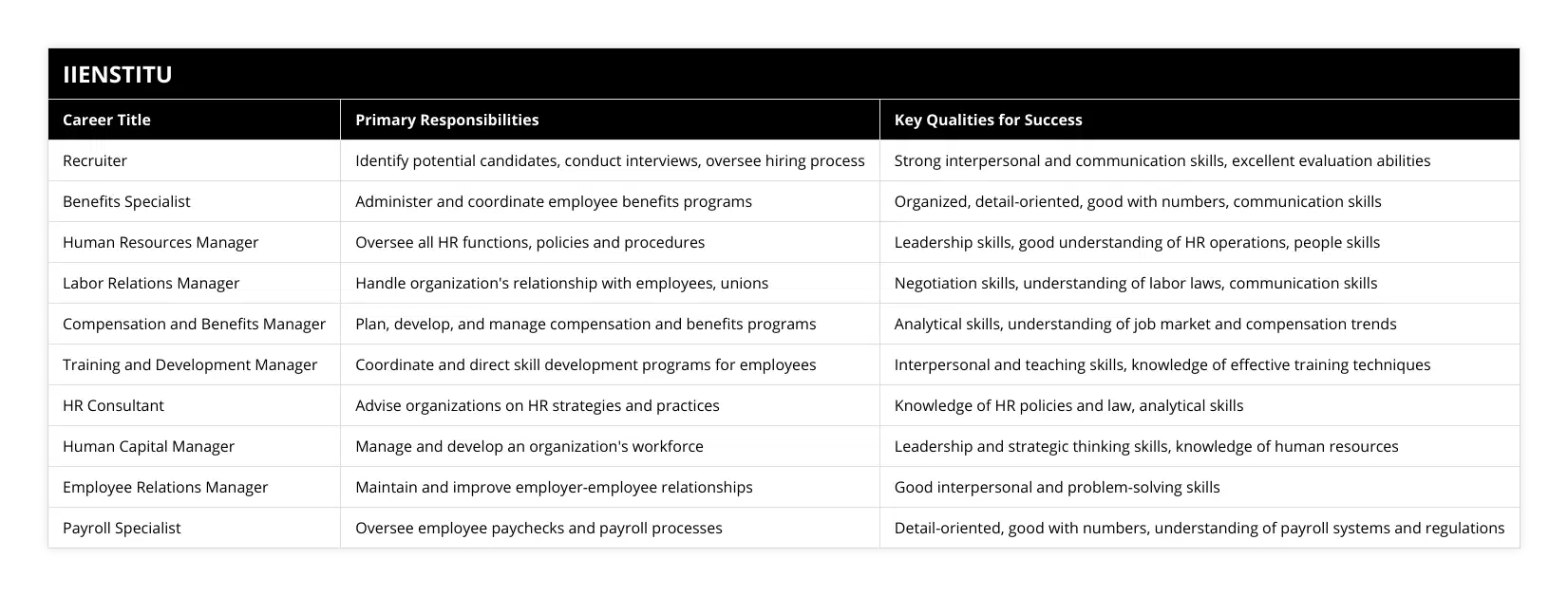
Frequently Asked Questions
What qualifications are needed to pursue a career in Human Resources Management?
In order to pursue a career in Human Resources Management, individuals should typically have a degree in a related field such as Human Resources, Business Administration, or Organizational Psychology. Relevant work experience in Human Resources can also be beneficial. Additionally, professional certifications such as Certified Professional in Human Resources (CPHR) or Human Resources Professional (HRP) can help demonstrate expertise in the field.
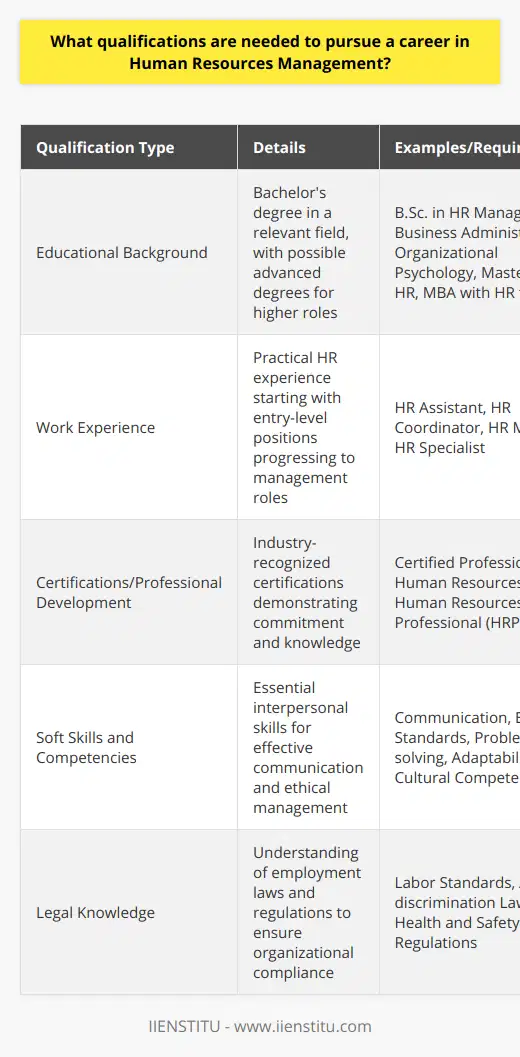
What skills are essential for success in Human Resources Management?
Communication: Being able to effectively communicate with all levels of the organization, including employees, supervisors, and executives, is essential for success in Human Resources Management.
Problem-solving: HR managers must be able to identify and resolve workplace issues quickly and efficiently.
Analytical Thinking: HR Managers must be able to analyze data, identify trends, and develop solutions to organizational problems.
Leadership: HR Managers must be able to lead, motivate, and manage the performance of their teams.
Organization: HR Managers must be able to plan, organize, and manage the activities of the HR department.
Knowledge of Laws and Regulations: HR Managers must be familiar with local, state, and federal laws and regulations related to employment, labor, and other HR-related issues.
Conflict Resolution: HR Managers must be able to identify and resolve disputes between employees and management.
Recruiting: HR Managers must be able to effectively recruit and retain top talent for their organization.
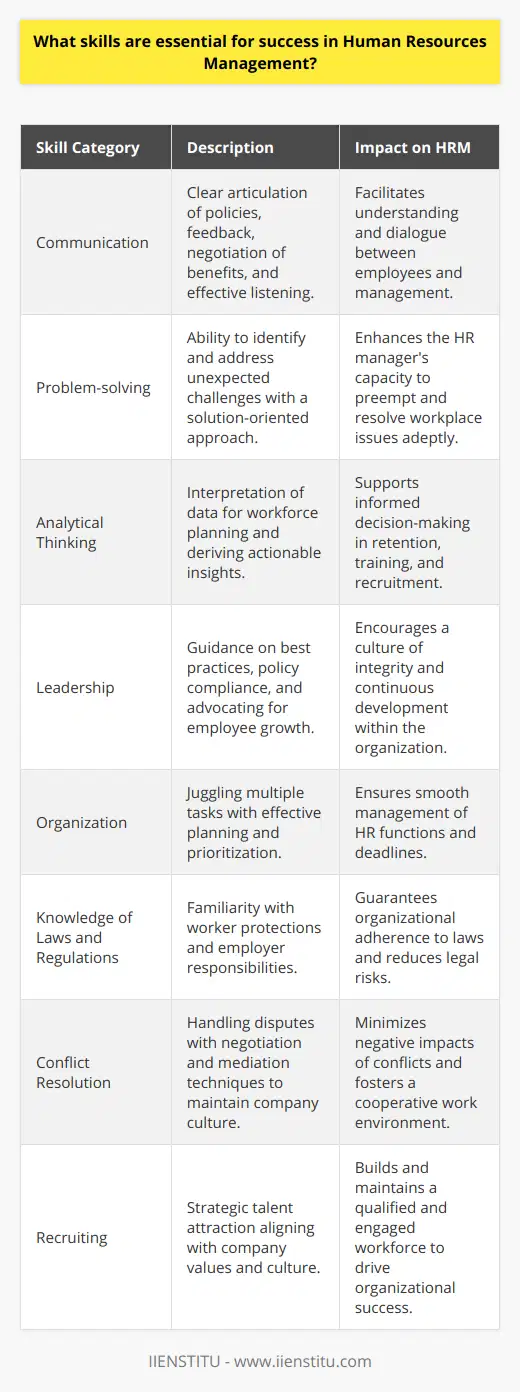
What are the most common job roles within Human Resources Management?
The most common job roles within Human Resources Management include:
-Human Resources Manager
-Human Resources Generalist
-Recruiter
-Compensation and Benefits Manager
-Employee Relations Manager
-Training and Development Manager
-Labor Relations Manager
-Organizational Development Manager
-Human Resources Information System (HRIS) Manager
-Employment Law Specialist
-Recruitment Manager

What are the primary responsibilities of a Human Resources Manager in an organization?
Roles of a Human Resources Manager
Recruitment and Selection
One of the primary responsibilities of a Human Resources Manager in an organization is to oversee the process of recruitment and selection of new employees. This involves creating job descriptions, posting job ads, screening applications, conducting interviews, and ensuring the best candidates are selected to join the company.
Training and Development
The Human Resources Manager is also responsible for facilitating employee development and training, with a goal to maintain a competent and skilled workforce. This includes identifying training needs, designing training programs, and evaluating the effectiveness of such initiatives.
Performance Management
Human Resources Managers play a crucial role in implementing performance management systems. They work together with line managers and employees to set performance objectives, establish clear targets, and create an environment that fosters continuous improvement and employee growth.
Compensation and Benefits
One of the critical responsibilities of a Human Resources Manager is to develop a fair and competitive compensation and benefits system. This includes designing salary structures, managing employee benefits, and ensuring equitable pay practices to attract and retain exceptional employees.
Employee Relations
Human Resources Managers serve as intermediaries between employees and management to address any workplace conflicts or concerns. They are responsible for fostering positive employee relations, coaching managers on effective communication, and resolving workplace disputes.
Legal Compliance
An essential responsibility of a Human Resources Manager is to ensure that the organization remains compliant with all employment laws and regulations. This includes staying updated on new legislation, developing policies, and providing guidance and support to managers and employees to maintain a lawful and ethical work environment.
In conclusion, the primary responsibilities of a Human Resources Manager encompass recruitment, training and development, performance management, compensation and benefits, employee relations, and legal compliance. Through these functions, HR Managers contribute significantly to an organization's success, ensuring a solid workforce, motivating employees, and maintaining a productive and compliant work environment.

Can you elaborate on the various types of human resources departments and their functions?
Types of Human Resources Departments
Organizational Structure-Based HR Departments
Different kinds of human resources departments exist depending on the organizational structure. In a centralized HR department, responsibilities and tasks are pooled into a single location with a dedicated team that oversees the entire organization. This consolidates decision-making, promotes consistency, and allows for specialized personnel, such as recruiters and compensation analysts, to be utilized more efficiently.
In contrast, decentralized HR departments operate with HR professionals or teams allocated to different units or divisions within an organization. This approach encourages greater flexibility and customization, as HR professionals can better align their initiatives with the unique requirements of each division.
Functional Area-Based HR Departments
Human resources functions can be divided into various specialized sub-departments. Recruitment and staffing departments are responsible for searching and selecting qualified employees to fill vacant job positions. They often use applicant tracking systems, assess resumes, conduct interviews, and even facilitate the onboarding process for new hires.
Compensation and benefits departments focus on determining appropriate remuneration for employees. They create salary structures and benefit packages, monitor industry salary trends, and administer payroll. Their primary goal is to design competitive and equitable compensation systems to attract and retain talent, while ensuring compliance with labor laws.
Employee relations departments manage the overall workplace atmosphere and promote a positive employer-employee relationship. They handle HR policy creation and enforcement, conflict resolution, and employee advocacy. This department is vital in maintaining a harmonious working environment and ensuring compliance with labor laws and regulations.
Training and development departments cater to the ongoing growth and capacity-building of the workforce. They analyze employee skill gaps and competencies, implement training programs, and evaluate their effectiveness. Additionally, they may oversee career development initiatives and performance management.
Overall, the types and functions of human resources departments vary based on an organization's structure and needs. Each type or functional area of HR serves its unique purpose in supporting the overall goals of the organization and creating a productive and satisfying work environment for employees.

How can one determine which Human Resources job is best suited for their skill set and career goals?
Analyzing Personal Skills and Interests
To determine the most appropriate Human Resources job based on one's skill set and career goals, an individual needs to carefully analyze their own personal interests, natural abilities, and acquired skills. Reflecting on personal experiences, past accomplishments, or aptitudes can provide valuable insight into the areas where one excels.
Exploring the Different HR Roles
The field of Human Resources encompasses a wide range of roles and responsibilities, such as recruitment, employee relations, learning and development, and compensation and benefits. Gaining a thorough understanding of these various areas through research and networking can help individuals pinpoint which specific roles align with their skill set.
Assessing Transferable Skills
Considering the transferable skills one has developed from previous roles or education can be extremely beneficial. Individuals can draw parallels, identifying those skills that are pertinent to a potential Human Resources career, such as communication, problem-solving, and decision-making abilities.
Evaluating Career Goals and Growth Opportunities
It is important for aspiring professionals to evaluate their desired career trajectory and long-term objectives. This evaluation will enable them to choose a Human Resources position that complements their desired growth opportunities and aligns with their personal aspirations, ensuring a fulfilling and rewarding career path.
Seeking Advice and Guidance
Reaching out to experienced Human Resources professionals for guidance or mentorship can be instrumental in identifying a suitable career path. Their knowledge and expertise can provide valuable input on various Human Resources roles, their inherent challenges, and the required skills for success.
Engaging in Professional Development
Finally, engaging in continuous professional development through industry certifications, workshops, or seminars can assist in determining and refining the most relevant skill set for a successful Human Resources career. Acquiring new skills and knowledge will not only establish a strong foundation of expertise but also allow the individual to better understand their areas of strength and interest within the profession.
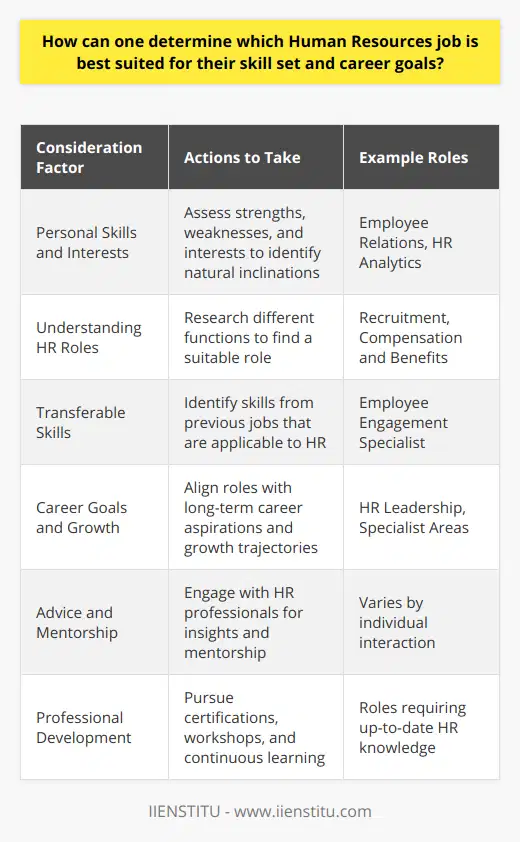
What are the key strategies for effectively implementing human resource policies in an organization?
Organizational Alignment
A fundamental strategy for effectively implementing human resource policies is ensuring alignment with the organization's overall vision and mission. This involves aligning HR policies with the company's goals and objectives, ensuring that they support and promote the desired company culture.
Effective Communication
Clear and consistent communication is essential in implementing HR policies, as it helps employees understand the purpose and benefits of the policy. Managers and leaders should disseminate information through various channels, such as meetings, intranets, or written documents, to enhance employee awareness and comprehension.
Customization and Flexibility
Since each organization is unique, customization of HR policies is crucial for adequate implementation. This may involve creating specific guidelines for different departments or roles within the company. Moreover, providing flexibility within these policies allows for adaptation to individual circumstances, ensuring fair and equitable treatment.
Training and Support
Proper training is vital in the implementation of HR policies to ensure that employees understand the policy and its practical application. This may include workshops, seminars, or online courses. Additionally, offering support services, such as HR helplines or employee assistance programs, encourages employees to seek help when faced with challenges related to the policy.
Monitoring and Evaluation
Continuous monitoring and evaluation are necessary to assess the effectiveness of HR policies. This may involve gathering feedback, conducting surveys, or analyzing relevant key performance indicators. Systematic review of policy performance provides valuable insights into areas where improvements are needed or adjustments need to be made.
Enforcement and Accountability
A critical aspect of effective implementation is the enforcement of HR policies and holding employees accountable for their actions. Clear consequences for non-compliance must be established and consistently enforced by management. This includes addressing policy violations, rewarding compliance, and ensuring a fair and transparent system of accountability.
In conclusion, effective implementation of human resource policies requires organizational alignment, effective communication, customization and flexibility, training and support, monitoring and evaluation, and enforcement and accountability. These strategies together ensure that HR policies are well understood, integrated into company culture, and effectively promote desired behaviors within the organization.
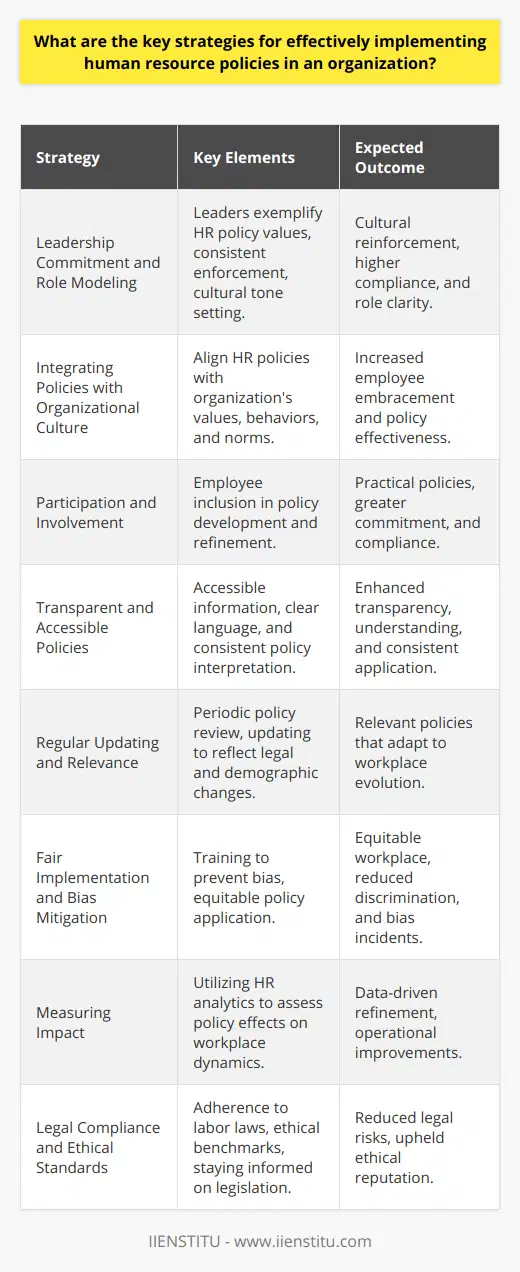
How do globalization and technological advancements impact the roles and responsibilities of HR managers?
The Effects of Globalization on HR Management
Globalization has significantly altered the landscape of the business world, leading to increased complexity and interdependence among organizations. Consequently, human resource (HR) managers face new challenges and responsibilities in managing diverse workforces, cultural differences, and legal environments. This shift has driven the need for HR managers to develop a deeper understanding of the global market, as well as to acquire a diverse skill set that enables them to effectively address cross-cultural issues.
Technological Advancements in HR Management
The rapid advancement of technology and the internet has also heavily impacted the role of HR managers. These technologies have enhanced productivity, communication, and collaboration across global teams, thus necessitating HR managers to adapt their strategies around the capabilities of new tools. Furthermore, digital innovations in recruiting and talent acquisition have prompted HR managers to embrace digital platforms for sourcing, interviewing, and onboarding employees. Additionally, HR managers must stay current with technological trends and the evolving digital landscape, ensuring that their organizations remain competitive in the talent marketplace.
Remote Workforce Management
With globalization and technological advancements, the remote workforce has become a more prominent aspect of modern organizations. As such, HR managers must reassess their traditional methods of managing employees to address the unique challenges and opportunities accompanying remote work. This includes creating and implementing remote work policies, adapting employee training and performance management systems, and ensuring that remote employees remain engaged and integrated within the larger organizational culture.
Ethical Considerations and Compliance
Globalization and technological advancements have increased the need for HR managers to maintain ethical standards and legal compliance across multiple countries and cultures. This requires thorough knowledge of local employment laws, regulations, and cultural norms to ensure proper implementation of HR policies and practices. Additionally, HR managers must navigate the ethical challenges arising from data privacy and the management of sensitive employee information. This necessitates a solid understanding of best practices in data protection and national and international regulations concerning data privacy.
In conclusion, globalization and technological advancements have significantly impacted the roles and responsibilities of HR managers. As a result, HR professionals must navigate the complexities of managing diverse and remote workforces, implement advanced digital technologies and tools, and address the ethical considerations and compliance issues inherent in a global business environment. By meeting these challenges head-on, HR managers can ensure that their organizations remain competitive in an increasingly complex and interconnected world.
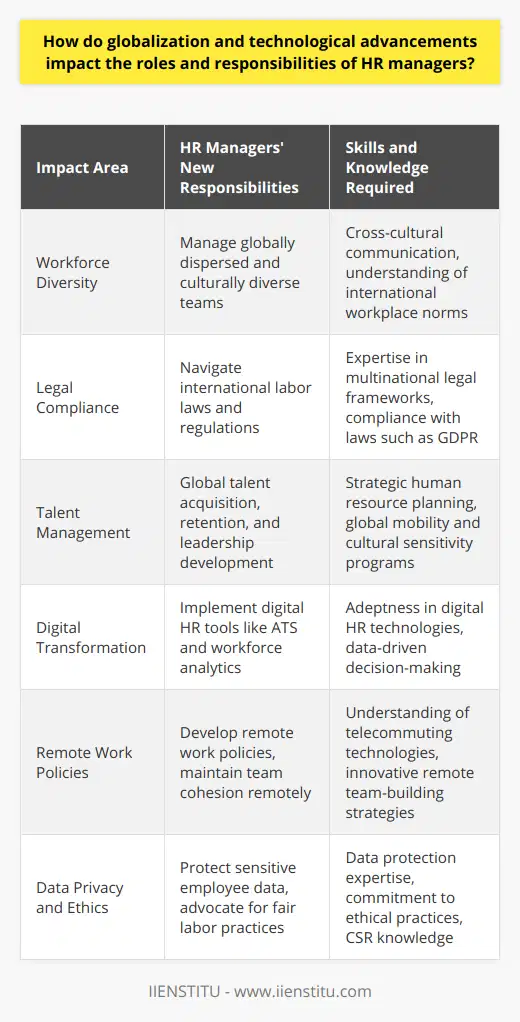
What are the ethical considerations and challenges faced by Human Resources professionals in maintaining a diverse and inclusive workplace?
Ethical Considerations
Human Resources (HR) professionals play a crucial role in promoting and maintaining a diverse and inclusive workplace. They face several ethical considerations and challenges in ensuring fairness, equity, and a sense of inclusion among employees. One such challenge is navigating the fine line between promoting diversity and being discriminatory. In their efforts to create a diverse workforce, HR may unintentionally discriminate against certain individuals or groups. This may lead to an increase in the likelihood of legal issues and a decline in overall employee morale.
Proactive Measures
To avoid discrimination and legal concerns, HR professionals must develop clear policies and guidelines addressing diversity and inclusion. This includes implementing hiring practices that promote diversity, like considering a diverse pool of candidates without any biases. Additionally, HR must offer training to employees on diversity, inclusion, and unconscious bias to foster a more inclusive work environment. Constant monitoring of these initiatives is necessary to evaluate their effectiveness in creating a truly diverse workplace.
Challenges in Communication
Another challenge faced by HR professionals is ensuring effective communication between diverse employees. Miscommunication may lead to conflicts and misunderstandings due to cultural, linguistic or other differences. HR must develop strategies to facilitate cross-cultural communication within the organization, such as implementing language training programs or using translation services for employees. These initiatives can help create a conducive environment for understanding and cooperation among employees of diverse backgrounds.
Addressing Discrimination
Despite their efforts, HR professionals may still face incidents of workplace discrimination. Addressing these incidents effectively and ethically can be challenging. Firstly, HR must ensure a transparent and confidential process for reporting discrimination or harassment. They must also take prompt action to investigate complaints, and if necessary, impose appropriate sanctions on the perpetrator. In doing so, HR must remain objective and impartial to prevent any liability issues arising from mishandling the situation.
Supporting Mental Health
Maintaining a diverse and inclusive workplace also involves supporting the mental health and well-being of employees. HR must be sensitive to the unique challenges that employees of diverse backgrounds may face, such as dealing with microaggressions or other subtle forms of discrimination. They must provide a supportive environment to address these concerns and offer resources such as counseling services, information on coping strategies, and targeted workshops. In this way, HR can contribute to a mentally healthy and inclusive workspace.
In conclusion, HR professionals face various ethical considerations in maintaining a diverse and inclusive workplace. To overcome these challenges, they must adopt proactive measures, promote effective communication, address discrimination promptly, and support employees' mental health. By doing so, HR can contribute to fostering a work environment that embraces diversity and inclusion, benefitting both employees and the organization as a whole.
